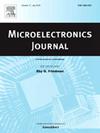应用于物联网的可扩展、低功耗、高性能有源 RC 复杂带通/低通滤波器,具有自动频率调谐功能
IF 1.9
3区 工程技术
Q3 ENGINEERING, ELECTRICAL & ELECTRONIC
引用次数: 0
摘要
本文介绍了一种带有自动截止频率调谐电路的综合第 3 切比雪夫有源-RC 复合带通/低通滤波器。所设计的滤波器可在 -6 dB-24 dB 范围内实现 2 dB 阶跃增益控制,并具有 4 种不同的带宽模式,包括低通模式和复合带通模式。为满足滤波器的严格性能要求,还采用了带有前馈补偿和反向极点分裂技术的紧凑型全差分(FD)放大器。新型放大器的开环增益达到 62 dB,最大单增益带宽 (UGB) 为 732 MHz,VDD = 0.9 V,功耗为 0.32 mW。使用所提出的放大器,该滤波器实现了文献中报道的有源 RC 实现的最低功耗,与类似的有源 RC 滤波器相比,功耗降低了 30%。通过采用动态分配级间增益的优化方案,该滤波器实现了 +25.7 dBm 的最大带内 IIP3,提高了 2 dB。此外,还采用了自动频率调整方案来消除工艺变化的影响。该滤波器采用 22 nm CMOS 工艺制造,占地面积为 0.44 mm × 0.44 mm,在 Wi-Fi 和 BLE 模式下,0.9 V 电源电压的功耗分别为 1.8 mW 和 1.2 mW。RC 调谐电路的精度为 1.5%,覆盖范围为 20%。本文章由计算机程序翻译,如有差异,请以英文原文为准。
Scalable, low-power and high-performance active-RC complex band-pass/low-pass filter with automatic frequency tuning applied to the Internet of Things
This article introduces a comprehensive 3rd Chebyshev active-RC complex band-pass/low-pass filter with an automatic cut-off frequency tuning circuit. The designed filter achieves 2 dB step gain control within the range of −6 dB–24 dB and 4 different bandwidth modes including low-pass modes and complex band-pass modes. A compact fully-differential (FD) amplifier with feedforward compensation and reverse pole splitting technique is used to meet the stringent filter's performance. The novel amplifier achieves an open loop gain of 62 dB and a maximum unity-gain bandwidth (UGB) of 732 MHz with VDD = 0.9 V and 0.32 mW of power dissipation. Using the proposed amplifier, the filter achieves the lowest power consumption reported in the literature for active-RC implementations and 30 % power reduction over similar active-RC filters. By employing an optimized solution for dynamic allocation of inter-stage gain, the filter achieves a maximum in-band-IIP3 of +25.7 dBm and an improvement of 2 dB. Also, an automatic frequency tuning scheme is used to eliminate the effect of process variation. The filter is fabricated in 22 nm CMOS process occupying 0.44 mm 0.44 mm area and consuming 1.8 mW and 1.2 mW from 0.9 V supply voltage in Wi-Fi and BLE modes, respectively. The maximum figure of merit (FoM) is 142.6 dB/J. The RC tuning circuit has a precision of 1.5 % and covers a range of 20 %.
求助全文
通过发布文献求助,成功后即可免费获取论文全文。
去求助
来源期刊

Microelectronics Journal
工程技术-工程:电子与电气
CiteScore
4.00
自引率
27.30%
发文量
222
审稿时长
43 days
期刊介绍:
Published since 1969, the Microelectronics Journal is an international forum for the dissemination of research and applications of microelectronic systems, circuits, and emerging technologies. Papers published in the Microelectronics Journal have undergone peer review to ensure originality, relevance, and timeliness. The journal thus provides a worldwide, regular, and comprehensive update on microelectronic circuits and systems.
The Microelectronics Journal invites papers describing significant research and applications in all of the areas listed below. Comprehensive review/survey papers covering recent developments will also be considered. The Microelectronics Journal covers circuits and systems. This topic includes but is not limited to: Analog, digital, mixed, and RF circuits and related design methodologies; Logic, architectural, and system level synthesis; Testing, design for testability, built-in self-test; Area, power, and thermal analysis and design; Mixed-domain simulation and design; Embedded systems; Non-von Neumann computing and related technologies and circuits; Design and test of high complexity systems integration; SoC, NoC, SIP, and NIP design and test; 3-D integration design and analysis; Emerging device technologies and circuits, such as FinFETs, SETs, spintronics, SFQ, MTJ, etc.
Application aspects such as signal and image processing including circuits for cryptography, sensors, and actuators including sensor networks, reliability and quality issues, and economic models are also welcome.
 求助内容:
求助内容: 应助结果提醒方式:
应助结果提醒方式:


